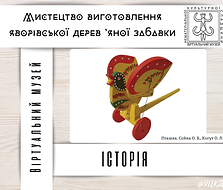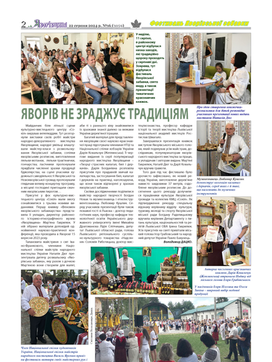The history of the Yavoriv toy
The Yavoriv toy has proven its viability and modernity over many centuries, experiencing positive and negative influences in each era. The Yavoriv wooden toy provides a unique opportunity to trace its development, consistent and continuous in the change of generations and dynasties of craftsmen, for more than a hundred years.
Its artifacts, both ancient and created by current masters, are kept in museum and private collections in Ukraine and around the world, reflecting the tastes and trends of the time and testifying to the canon formed throughout history.
Written sources attest to the production of wooden toys in Yavoriv in the 17th century. The active period for the Yavoriv craft was the last third of the 19th and the beginning of the 20th centuries. At that time, toys made by craftsmen from Yavoriv and nearby villages reached the markets of Poland, Germany, and other European countries.





The Yavoriv toy, unique in its plastic form and polychrome ornamental painting, is a significant page of decorative and applied art.
Its production was concentrated in the Lviv region, in the city of Yavoriv and nearby villages. The origin and originality of the Yavoriv toy is confirmed by the unique decor, which has analogies in Yavoriv embroidery, weaving, and chest painting.
The high artistic value of the Yavoriv toy is enhanced by its environmental friendliness, thanks to the use of wood and safe dyes, as well as expressive play capabilities, including the ability to create movement and sound.
Entertainment school
In 1896, a training workshop for the production of toys was opened in Yavoriv, which became known as the Toy School. The school aimed to create a solid technical and economic basis for the further development of the industry, which at that time began to decline due to the appearance of foreign toys. The production of new models was introduced into the curriculum: in the carving department - animal figures; in the turning department - skittles, croquets; in the carpentry department - toy houses, cubes for assembling "pictures", targets, etc. The systematic production of these was supposed to teach the younger generation to produce and later design toys themselves, which were
would be competitive and meet market requirements. The school's priority tasks included improving, "ennobling" traditional toys.
During World War I, the school, which had been called the "State School of Woodworking" since 1905, was closed. During the interwar period, the school periodically resumed classes, but its main focus was on training carpenters.
New prospects for the development of the Yavoriv toy were outlined in the State School of Woodworking, opened in 1942 under the leadership of Bohdan Stebelski, a graduate of the Krakow Academy of Arts: based on ancient artistic traditions, to introduce toys "... that would not only arouse the child's interest in playing, but would develop aesthetic taste, and would connect the child with Ukrainian spirituality." A museum of folk toys was organized at the school. During the year, the game "Zaporozhskaya Sich" was designed by the joint efforts of teachers and students. In May 1944, the school was closed.
Learn more about the history of the Yavoriv toy on the pages of the book series "Virtual Museum"
continuation, and development of traditions
At the same time, during the 20th century, many craftsmen joined in the continuation and development of the artistic traditions of Yavoriv toys. In the 1920s–1930s, about 75 families made toys in the Small Suburb of Yavoriv, including the Bryndas, Horbulki, Horokh, Hdul, Pryym, and Ferentz. In the 1950s–1980s, craftsmen Vasyl Pryyma, Stepan Tyndyk, Stepan Firchuk, Stepan Lopachak, Stepan Horokh, and others actively worked in line with local traditions. In the early 1990s, only two craftsmen made toys in the Small Suburb — Yulia Pryyma and Stepan Lopachak. In the early 2000s, the traditions of Yavoriv toymaking were continued by the family of Olga and Vasyl Login and Yevhen Ferentz. Thanks to the craftsmen who worked in the center, inherited the techniques of creating toys and introduced innovations, coordinated and subordinated them to the peculiarities of worldview and aesthetic tastes of the environment, the phenomenon of the Yavoriv toy was created and exists.
The first quarter of the 21st century was marked by a surge of sustained interest in Yavoriv wooden toys and the study of their local features.
During 2008–2009, exhibitions of Yavoriv toys were held in Yavoriv, Drohobych, Lviv region, Lviv, Kosiv, Ivano-Frankivsk region, Ivano-Frankivsk, and Kyiv. The reconstructions of authentic works for which were carried out by masters Anton Gula, Vasyl Yaremin, Semen Tlusty, Roman Prystavsky, and Taras Tlusty.





Ostap Soyka

Oksana Kohut
In 2009, Oksana Kohut and Ostap Soyka united their intentions to continue the traditions of Yavoriv toys. The craftsmen create traditional toys - horses, carts, birds, furniture, rattles, tarakhkalets, dancers. Along with established types, they offer original works: "spring flowers", birds, stars, pegasus, a series of angels with musical instruments - trumpet, tambourine, cymbals, violin, cello, double bass, which can serve as interior decoration, Christmas tree or wreath decoration.
author's works
Figures, plastically designed and painted by Oksana Kohut and Ostap Soyka, decorated the main Christmas tree of Lviv, Kyiv, and the Vatican. Oksana Kohut and Ostap Soyka successfully embodied the visual image of the Yavoriv toy in their original works “Carol Star” and “Carol Shopka”, which are still relevant in the celebration of Christmas. In the nativity scene, biblical characters — shepherds, kings, Mary, Joseph, baby Jesus in a cradle — are carved from wood, painted in the colors traditional for the Yavoriv toy and located in a painted chest; with the help of a special mechanism, they can move in a circle. During the 2023–2024 Christmas holidays, the nativity scene by Oksana Kohut and Ostap Soyka was presented at the exhibition “100 Nativity Scenes in the Vatican” on St. Peter's Square.




awards, exhibitions and festivals
Since 2012, Oksana Kohut and Ostap Soyka have been representing the Yavoriv toy at international art events - a festival in Buyukcekmece (Turkey), the Jagiellonian Fair in Lublin (Poland), etc.
In 2013, the creative works of the masters were awarded a diploma in the nomination "Traditional-Regional Ukrainian Toy" at the All-Ukrainian Competition of Ukrainian Folk Toys, which was held by the State Museum of Toys in Kyiv.
The priority in the work of Oksana Kohut and Ostap Soyka is to preserve the authentic image of the Yavoriv toy, which determines the lapidary nature of the joinery form, bright painting with plant motifs in yellow-green-red colors. The masters combine their enthusiasm for creativity with a sincere desire to interest children in the traditional toy, passing on to them the secrets of creativity at master classes.
collectible coins
In 2019, the National Bank of Ukraine issued a commemorative set of coins "Yavorivska zabavka" with a denomination of 2 hryvnias:



Ukraine. Tradition. Transformation.
2010, Ethnographic Museum, Zagreb, Croatia
Ethno doll
2011, Lviv Palace of Arts
All-Ukrainian exhibition of folk toys
2011, National Union of Folk Masters of Ukraine, Kyiv
Exhibition of Yavoriv toys
2013, State Memorial Museum of Mykhailo Hrushevsky in Lviv
Exhibition of Yavoriv toys
2013, National Museum of Folk Art of Hutsul and Pokuttya named after Josaphat Kobrynsky, Kolomyia
Mom, Dad, Me + Toy = Universe"
2013, Chernivtsi Regional Museum of Local Lore
Folk art of Yavoriv region
2014, National Museum in Lviv named after Metropolitan Andrey Sheptytsky
Exhibition "Yavoriv Toy" and entertainment project by Oksana Kohut and Ostap Soyka "Play"
2014, National Museum in Lviv named after Metropolitan Andrey Sheptytsky
Exhibition of Yavoriv toys
Museum of Folk Architecture and Life in Lviv named after Klymentiy Sheptytsky
Christmas with family
2023, State Toy Museum, Kyiv
Yavoriv toy as an element of the intangible cultural heritage of Ukraine
The Yavorivka toy is the most famous wooden Ukrainian folk toy. The tradition of making this toy goes back thousands of years, as evidenced by its stylistic similarity to the traditional wooden toy of the Croatian Zagorje, which is included in the UNESCO Masterpieces of the Oral and Intangible Cultural Heritage of Humanity. The art of making the Yavorivka wooden toy has not yet received such an international status, but it is already included in the National List of Elements of the Intangible Cultural Heritage of Ukraine.

















